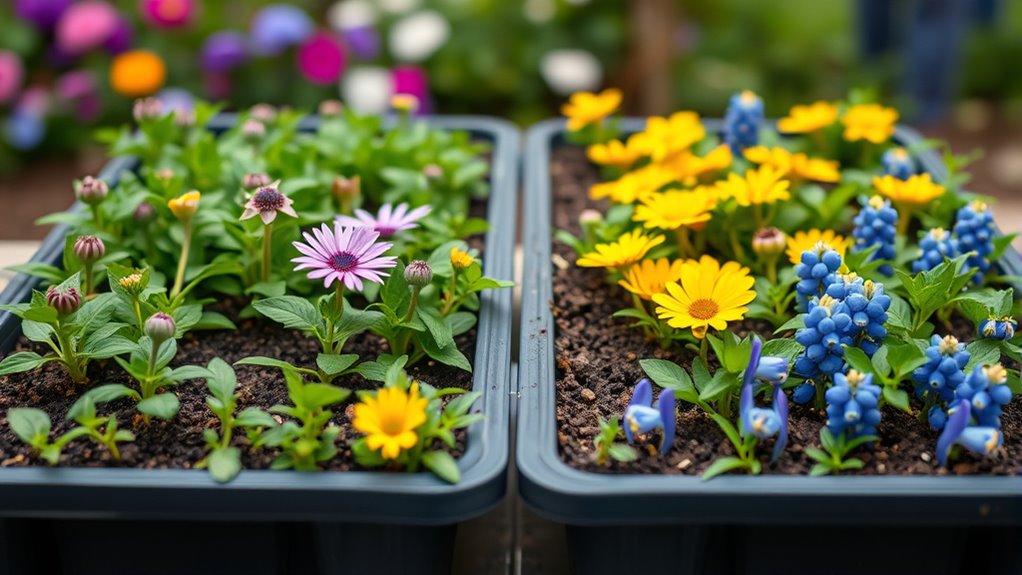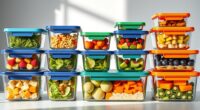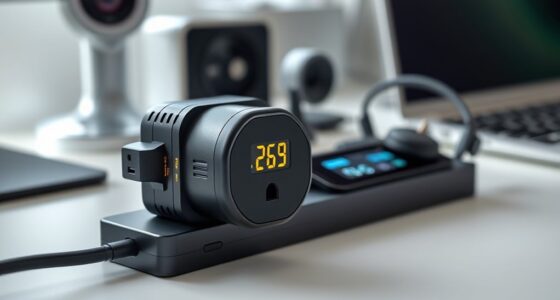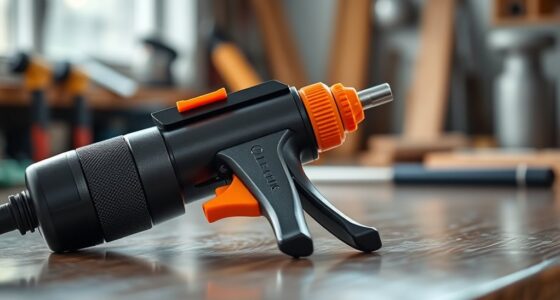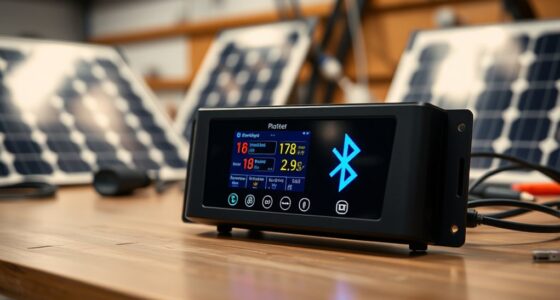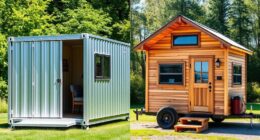If you’re looking to boost your garden’s beauty and biodiversity, I recommend choosing native wildflower plug trays that suit your local climate and soil conditions. Native species like Brown-Eyed Susan and other late-summer bloomers attract pollinators and thrive with minimal care. Look for trays that match your site’s moisture needs and provide a variety of bloom times for continuous color. Keep exploring to discover how to select the best options for a thriving, eco-friendly garden.
Key Takeaways
- Choose native wildflower plug trays suited to your USDA hardiness zone for better survival and ecological compatibility.
- Select trays with a diverse mix of species that bloom at different times to ensure continuous pollinator support.
- Prioritize native species adapted to your soil type and moisture conditions to maximize growth success.
- Opt for locally sourced or reputable suppliers offering healthy, well-established plugs to reduce transplant shock.
- Consider cost, availability, and plant variety to balance budget and biodiversity goals effectively.
3 Live Brown-Eyed Susan Plants (Rudbeckia triloba) – Perennial Wildflowers

If you’re looking to create a vibrant, pollinator-friendly garden, our Live Brown-Eyed Susan Plants are an excellent choice. These three perennials come in 4-inch pots, already healthy and ready to plant. They grow quickly thanks to their well-developed roots and are grown organically. Their bright yellow flowers with dark centers resemble miniature Black Eyed Susans, blooming from summer into fall. Suitable for zones 4–8, they thrive in full sun and well-drained soil. As low-maintenance, drought-tolerant, and deer-resistant plants, they support butterflies, bees, and birds. They’re perfect for native landscapes, adding color and attracting pollinators effortlessly.
Best For: gardeners seeking low-maintenance, pollinator-friendly perennial plants to add vibrant color to native landscapes in zones 4–8.
Pros:
- Grows quickly with well-developed roots, ensuring rapid establishment
- Supports pollinators like butterflies, bees, and birds, enhancing biodiversity
- Drought-tolerant, deer-resistant, and easy to care for, making them ideal for sustainable gardens
Cons:
- Short-lived plants that may need replanting after several years
- Foliage can look tired by year’s end, requiring cutting back for regrowth
- Plants may require space of 12–18 inches apart, which may not suit very small garden beds
64 Outdoor Native Plants for Full Sun & Wet Ground
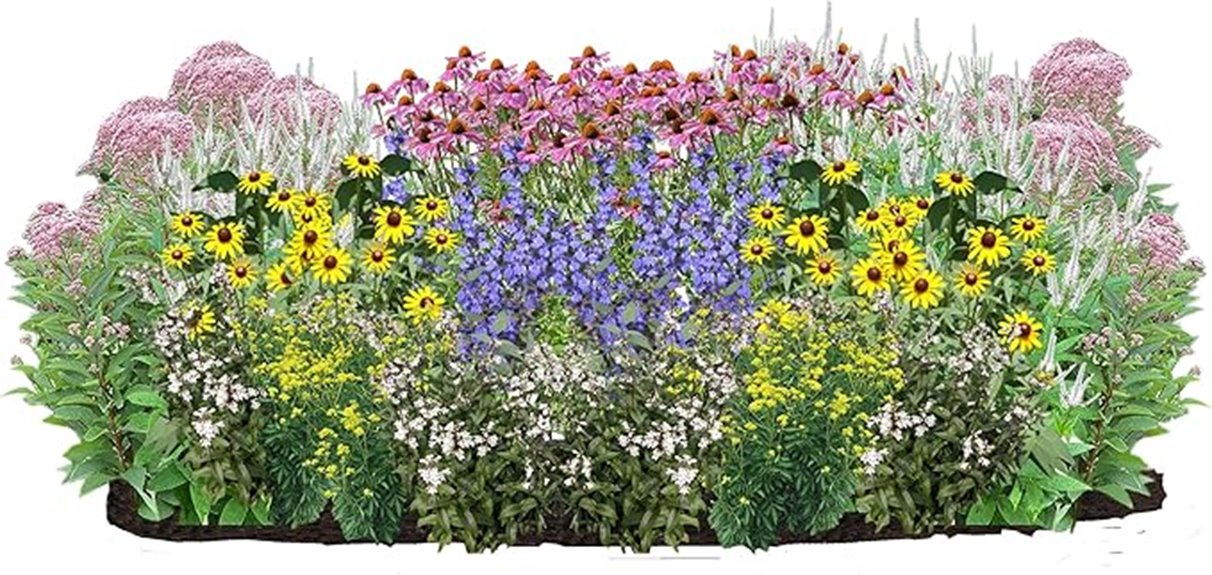
Native Wildflower Plug Trays are an ideal choice for gardeners seeking low-maintenance, pollinator-friendly plants that thrive in full sun and wet ground. These 64 live native perennials come in individual pots, ready to plant without germination delays. They include vibrant varieties like Purple Coneflower, Red Milkweed, and Sweet Joe Pye Weed, suited for US Zones 4–8. Organically grown with strong roots, they resist drought and deer, making them perfect for rain gardens and pollinator meadows. Once established, they require little watering. Customers love their quick growth and ecological benefits, adding abundant color and supporting bees, butterflies, and hummingbirds all season long.
Best For: home gardeners and landscapers seeking low-maintenance, native, pollinator-friendly plants for full sun and wet ground areas like rain gardens or meadows.
Pros:
- Ready-to-plant live perennials with strong root systems, no germination needed.
- Supports pollinators such as bees, butterflies, and hummingbirds, enhancing garden biodiversity.
- Drought and deer resistant, requiring minimal watering and maintenance once established.
Cons:
- Plants are relatively small upon arrival (4–8 inches), requiring patience for full growth.
- Limited color palette primarily in purples, pinks, and yellows; may not suit all aesthetic preferences.
- Only suitable for US Zones 4–8, which limits planting in colder or warmer regions outside this range.
Factors to Consider When Choosing a Native Wildflower Plug Tray
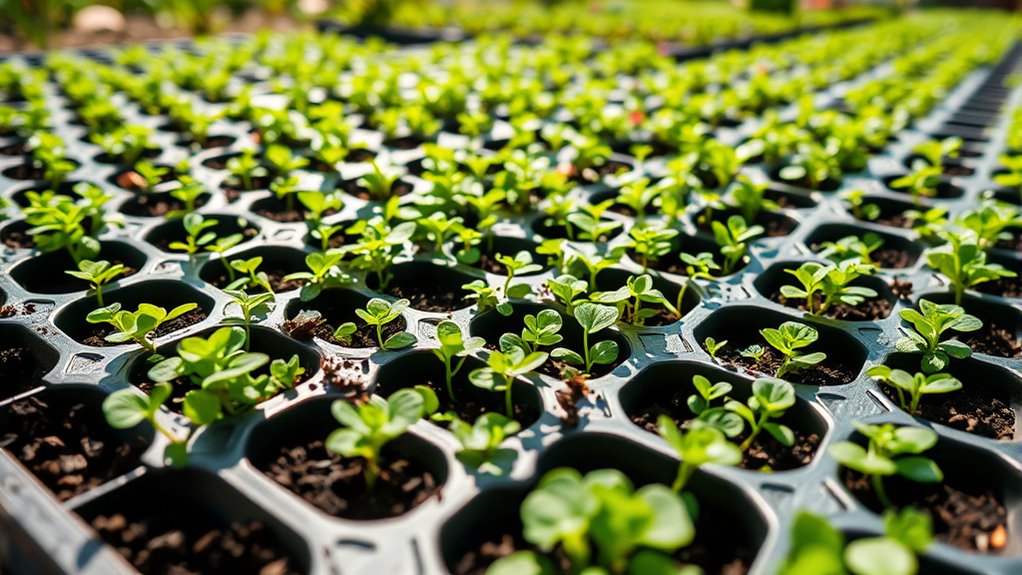
When selecting a native wildflower plug tray, I consider how well the species will match my site’s conditions and needs. Factors like soil type, moisture requirements, plant size, bloom time, and maintenance play a vital role in making the right choice. Paying attention to these points helps guarantee healthy growth and vibrant blooms.
Native Species Compatibility
Choosing the right native wildflower plug tray starts with understanding your local climate, soil, and sunlight conditions. It’s essential to select species that naturally flourish in your area, reducing maintenance and boosting survival. Make sure the plants you choose are suited to your region’s moisture levels, whether that’s wet ground or dry patches. Verify that the species are appropriate for your USDA hardiness zone so they can withstand winter temperatures. Additionally, consider ecological relationships like pollinator preferences and soil microbiomes to support local biodiversity. Matching native plants to your existing plant community helps maintain ecological balance and prevents invasive species from taking over. Overall, selecting compatible native species ensures a healthier, more resilient garden that thrives naturally in your environment.
Soil and Moisture Needs
Understanding the soil and moisture needs of native wildflowers is essential for successful planting. Different species have specific requirements; some thrive in well-drained soils, while others prefer consistently moist or wet conditions. Choosing plugs that match your site’s moisture level guarantees better establishment, reduces transplant shock, and promotes healthy growth. Many wildflowers are adapted to particular environments, like rain gardens or wetlands, which influences their long-term health and flowering. Properly considering soil type and moisture needs also helps prevent overwatering or drought stress, making your native planting more sustainable and low-maintenance. By selecting wildflower plugs suited to your soil’s moisture conditions, you support their survival, enhance your garden’s beauty, and contribute positively to local ecosystems.
Plant Size and Growth
Selecting the right size and growth habit of native wildflower plugs is essential for a successful planting. Most plugs are 2 to 4 inches tall, making them easy to transplant and establish quickly. Keep in mind that different species have varying growth rates; some will fill out a garden bed within a season, while others may take years to reach full size. It’s important to consider their mature size—some plants can spread or grow tall, which affects spacing and overall garden design. The initial size influences how well they compete with weeds and adapt to soil conditions early on. Understanding each plant’s growth habit helps prevent overcrowding and ensures healthy development, leading to a thriving, diverse native garden.
Bloom Time and Color
When planning a native wildflower garden, considering bloom time and color is essential for creating continuous visual interest and supporting pollinators throughout the season. Different wildflowers bloom at various times—from early spring to fall—ensuring there’s always something in flower. This variation helps attract a diverse range of pollinators and provides ongoing nectar sources. The colors of wildflower plugs, from yellow and purple to pink and white, influence both aesthetics and ecological benefits. Choosing a mix of bloom times and colors creates a vibrant landscape and promotes biodiversity. Brightly colored flowers, especially yellow and purple, are particularly effective at attracting pollinators. Understanding these factors allows me to design a garden that’s both beautiful and beneficial throughout the growing season.
Maintenance and Care
Choosing the right native wildflower plug tray involves considering how much maintenance you’re willing to do initially and throughout the growing season. These trays typically need minimal watering at first but benefit from consistent moisture until the plants are established. Regularly check for signs of stress or disease, removing any damaged or unhealthy plants to encourage healthy growth. Fertilization is usually unnecessary or light since native plants thrive in nutrient-poor soils, making ongoing care easier. After blooming, cutting back foliage helps promote vigorous growth and prepares plants for the next season with little effort. Mulching around the plants also helps retain soil moisture, suppress weeds, and reduce watering needs, making maintenance straightforward and less time-consuming overall.
Regional Climate Suitability
Understanding your regional climate is essential for ensuring your native wildflower plug trays thrive. I always start by checking the temperature ranges and seasonal variations in my area to choose plants suited to those conditions. Matching plants to your USDA hardiness zone helps prevent surprises during winter, ensuring they survive cold snaps. It’s also important to consider soil moisture levels—whether your soil tends to be wet or drought-prone—so you select species that tolerate those conditions, reducing watering needs. Additionally, evaluate local rainfall patterns and humidity; choosing wildflowers adapted to your area’s moisture levels promotes healthy growth. By selecting native species proven to thrive locally, you support ecological balance and minimize plant stress or failure, giving your garden the best chance to flourish naturally.
Cost and Availability
Cost and availability are important factors to contemplate when selecting native wildflower plug trays. The price varies based on quantity, plant variety, and supplier, so it’s crucial to compare options to stay within your budget. Bulk purchasing can lower the per-plant cost, making it more affordable for larger projects. However, availability can be unpredictable, often fluctuating seasonally or regionally, which may limit your choices of specific native species. Some trays might have limited stock due to seasonal demand or supply chain issues. To get the best deal, I recommend comparing prices across multiple vendors and considering both online and local suppliers. This way, you can find quality native wildflower plug trays that fit your needs without overextending your budget.
Frequently Asked Questions
How Long Does It Take for Wildflower Plugs to Bloom?
Wildflower plugs typically bloom within 6 to 12 weeks after planting, depending on the species and growing conditions. I’ve found that providing ample sunlight, proper watering, and good soil helps speed up blooming. Patience is key, as some native wildflowers might take a little longer to establish themselves before showing flowers. Keep caring for your plugs, and soon you’ll enjoy vibrant blooms that boost your garden’s beauty and biodiversity.
Can Native Wildflower Plugs Be Grown in Containers?
Yes, native wildflower plugs can definitely be grown in containers. I’ve had success planting them in pots or raised beds, making it easy to control soil and watering. Just choose a container with good drainage, use native soil, and place it in a sunny spot. Regular watering and some patience will soon reward you with beautiful blooms, attracting pollinators and enhancing your garden’s natural charm.
What Soil Ph Is Best for Native Wildflower Plugs?
Think of soil pH as the tune your wildflowers sing—perfect harmony helps them thrive. I’ve found that most native wildflower plugs prefer a soil pH between 6.0 and 7.0, which is slightly acidic to neutral. This range supports healthy nutrient uptake and vibrant blooms. If your soil’s outside this range, a simple soil test can guide you to adjust pH levels, ensuring your wildflowers flourish beautifully.
How Often Should I Water Wildflower Plug Trays?
You should water your wildflower plug trays every 2-3 days, ensuring the soil stays consistently moist but not waterlogged. I recommend checking the soil’s top inch; if it feels dry, it’s time to water. During hot, dry weather, you might need to water more frequently. Always water gently to avoid disturbing the young roots, and adapt your watering schedule based on your local climate and soil conditions.
Are Native Wildflower Plugs Resistant to Local Pests?
Yes, native wildflower plugs are generally more resistant to local pests because they’re adapted to the environment. I’ve seen pests leave these plants alone, attracted instead to non-native species. Still, no plant is entirely immune. You might notice some pests, but native wildflowers often bounce back quickly, helping you maintain a healthy, vibrant garden. Keep an eye out, and your garden will thrive with minimal fuss.
Conclusion
Choosing the right native wildflower plug tray is like planting seeds of beauty and biodiversity in your garden’s future. I once watched a small patch of Brown-Eyed Susans transform a dull corner into a buzzing haven, reminding me how the right plants can truly make a difference. When you pick plants suited to your climate and soil, you’re not just gardening — you’re creating a lively, colorful ecosystem that blooms year after year.
